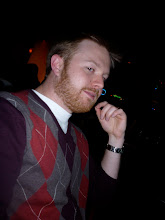Like Hitler, those who joined the party in the early 1920’s were social outcasts, many of whom had fought in World War I and felt the sting of defeat like Hitler. Angry and lost, many ex-soldiers had no direction following Germany’s humiliating loss, and in the Nazi party they found structure and a forum in which to vent their frustrations. Hitler, as the leader of the party, was able to appeal to the discontent of the masses, and tapped into their anger to fuel the Nazi ideology.
The ideas that Hitler promoted were to enable the German people to right the wrongs that World War I inflicted on them. Even though the Weimar Republic was doing well prior to the Great Depression, the Nazis had a grander vision of the German nation, and Hitler was the master of the plan. In the early days the plan was only known to a small number of angry workers and veterans.
 |
| Joseph Goebbels |
A man who saw eye to eye with Hitler and the ideas he promoted was Joseph Goebbels. Goebbels, first seeing Hitler at his trial in 1924, identified with him and saw the person that he believed could make his idea of a “just world” a reality. Like many of his generation, including Adolf Hitler, Goebbels was tormented by the loss of the war, but as he investigated the Nazi party, he began to see a ray of hope for himself and the German people. Born as a proud Prussian, Goebbels, like Hitler, felt he had something to prove all his life, and sought to vent his frustrations outwardly. Although the chip on his shoulder was different than Hitler’s, Goebbels had one nonetheless. Born with a deformed foot, and always seen as a sickly boy, Joseph’s misfortunes were seen by his parents as a punishment from God. His deformity, the source of ridicule and pity, Goebbels was a withdrawn sad youth who loved to read and write, and be alone with his thoughts.
Unlike Hitler, Goebbels did find some success prior to joining the party. Goebbels received a doctorate after writing a dissertation which included such themes as, “love of the Fatherland,” “spiritual greatness,” and “enthusiasm.” All of these ideas would be used by Goebbels in his eventual role as the Nazi’s chief propagandist. Neither Hitler nor Goebbels knew what they were creating as they joined forces, but each sought to find success in a world that had tried to keep them down in various ways.
Over time, Goebbels used his skills to get himself as close to Hitler as possible, seeing him as the unquestioned force behind the party. In effect, Goebbels had become what Hitler had originally thought for himself, and now it was Goebbels’ job to pave the way for Hitler and soak up as much reflected glory as possible. The 1920’s were a period in which the party was gaining momentum, with Hitler speaking and Goebbels creating propaganda.
The Depression made the people of Germany more receptive to radical ideas, and at the same time the Nazis hoped to become more mainstream, in order to gain power in the government. All of the party’s work paid off in 1930, as the Nazis won 107 seats in the Reichstag, becoming the nation’s second largest political party. The Nazis were now officially on the map, and men, like Hitler and Goebbels, who had been marginalized were now being taken seriously and gaining popular support. There were now others who had been left out in the cold that were coming to warm themselves in the glow of Nazism.



No comments:
Post a Comment